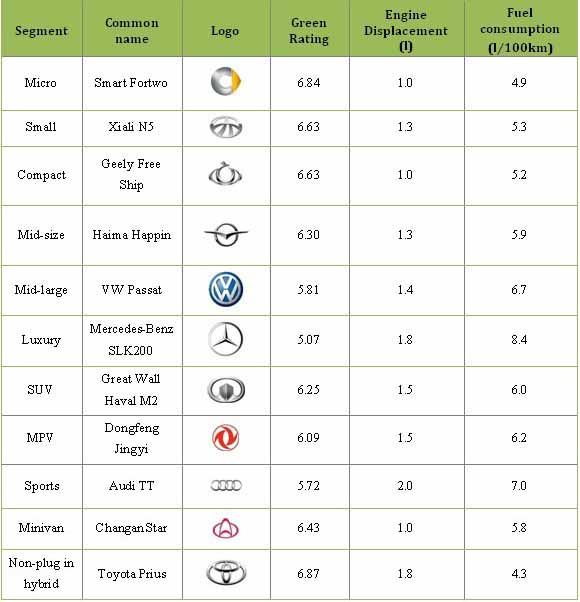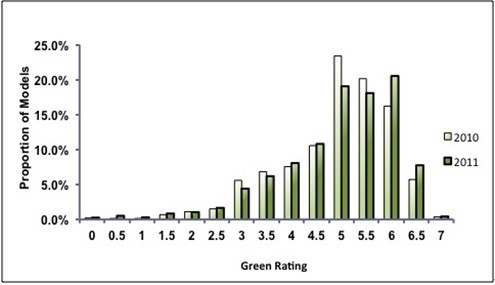News I iCET Releases China's Green Car 2011 Rankings
Following the first successful Environmentally Friendly Vehicle Rankings
released in April, 2011, the Innovation Center for Energy and Transportation
(iCET) has released for the second year in the row, the influential China
Environmentally Friendly Vehicle Ranking Report.
2011 Rankings –
Key Results
Greenest Overall Car in China: Toyota Prius Generation 2 hybrid
With an industry-leading Green Rating of 6.87 and a tiny fuel
consumption of 4.3 L/100km, the hybrid electric 2nd Generation Toyota Prius took
top prize in the 2011 China EFV Rankings, knocking the Honda Civic hybrid from
it’s top place in 2010. With a market price of RMB 225,800, the vehicle
incorporates global-leading energy efficiency and hybrid technologies and gives
the driver a distinctive green identity.
Greenest Conventional Car in China: the Smart Fortwo
For
the second year running, the Smart Fortwo ranked highest in green rating for
conventional vehicles available on the Chinese market. This light and tiny
two-seat vehicle has a low fuel consumption of 4.9 L/100 km, and meets China’s
National IV emission rating standard, giving it a Green Rating of 6.84. With
market prices ranging from RMB 110,000 – 180,000, the Fortwo offers convenient
urban mobility and high land- and energy- efficiency to its driver.
China's Most Popular Car Fails to Rank in the Top 10 Green Mid-size
Vehicle Segment
China's most popular car with sales of 253,514 in
2011 according sina.com, the mid-size Buick Excelle (known as the Kaiyue in
Chinese), received a Green Rating of 5.84 in its 2011 evaluation, failing to
make it into this year’s top 10 mid-size Environmentally Friendly Vehicles.
This year’s top Green performing mid-size vehicle was the Haima Happin (Haima
Haifuxing), whose sales did not rank in China’s mid-size segment top 10.
China's SUV Segment Kicks International Trends
Unlike
the SUV market in the US, China’s best-selling SUVs are relatively green.
2011’s top green performing SUV was the Great Wall Haval. Unlike larger
foreign-branded SUVs, this sensible vehicle incorporates the large interior
space and high ground clearance of a typical SUV with the footprint and engine
size truly suitable for an urban environment. With a Green Rating of 6.25, this
SUV performs better than the top-ranking mid-large segment VW Passat in terms of
environmental impact. The top-ranking foreign-branded SUV is the small-sized
Suzuki Jimmy, rated 5.88 with a 1.3 litre engine.
2011
Environmentally Friendly Vehicle Top-Performing Models by Market Segment

2011 Offers Greener Choices than 2010
iCET's Auto Analyst,
Mr. Tony Ma, when comparing the results of the 2010 and 2011 EFV ranking report
noted that the selection of vehicles in the Chinese market is gradually becoming
"Greener". The figure below shows that more vehicles are available in the 6-6.5
rating range in 2011 compared to 2010.
Proportion of Vehicle
Models in China According to Green Rating

Lower Fuel Consumption is Driving Greener Vehicle
Ratings
iCET Executive
Director, Dr. Feng AN, in an overview of the future of the Chinese auto
industry, said, "During the period of China's 11th Five Year Plan, a reduction
in national average fuel economy was unclear, having decreased by only 2.7% - a
poor result compared to Europe and Japan." According to iCET analysis, the
national average fuel consumption of new vehicles was 7.5 L/100km in 2011, a
decrease of 3.7% from 2010. At this rate, achieving the 2015 target fuel
consumption of 6.9 L/100 km should not be difficult. However, he said, "the
required 6-7% reduction in average fuel consumption per year required between
2015 and 2020 to achieve a 5 L/100km target will not be possible without the
heavy promotion of clean, new energy vehicles." Achieving such an aggressive
target will not just require an acceleration in technology development, it will
also require clear downsizing of new vehicles, lighter vehicles and smaller
displacement engines overall.
About the Ranking
The
Environmentally Friendly Vehicle rating system uses a methodology considering a
vehicle's weight, energy consumption and toxic emission rating in order to
calculate an overall rating of any vehicle’s impact on the environment over its
product lifetime. The methodology, developed through a project with China's
Ministry of Environmental Protection, Vehicle Emission Control Center, and in
cooperation with the US-based American Council for an Energy Efficient Economy
(ACEEE), makes use of vehicle information from authoritative sources such as The
Ministry of Environmental Protection, the Ministry of Industry and Information
Technology, and the China Association of Automotive Manufacturers, to develop a
relevant Green Rating score for consumers and government alike to use when they
purchase vehicles.
Each car's rating, given on a scale of 0-10, allows
consumers of vehicles to compare vehicles on a level playing field in terms of
the full lifecycle impact the vehicle has on the environment, in terms of fuel
consumption, Green House Gas (GHG) emissions, toxic emissions and resource
consumption. The ranking divides China’s automotive market into 11 market
segments in order to allow consumers to look at vehicles in the segment they
wish to make a purchase.
The 2012 report evaluates all the vehicles that
were available on the Chinese market for purchase in 2011.
EFV:
An Evolving Evaluation System
This year, iCET's EFV methodology was updated with
China's most recent environmental data, and is evolving to meet the needs of the
Chinese auto market. Besides adding a ranking category for hybrid vehicles
separate from conventional vehicles, iCET has also undertaken research into
the environmental impact of New Energy Vehicles on China's environment. While
there is some data available for such an evaluation to take place, it is
essential that China's government quickly release data on the energy consumption
and emissions of New Energy Vehicles – there is no doubt that including such
information on China’s existing information platforms will do nothing but
further but promote the responsible purchase and use of New Energy Vehicles in
China.